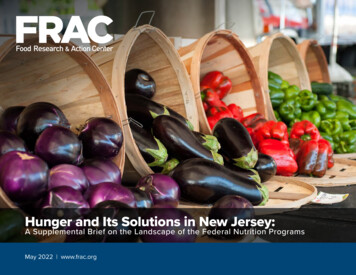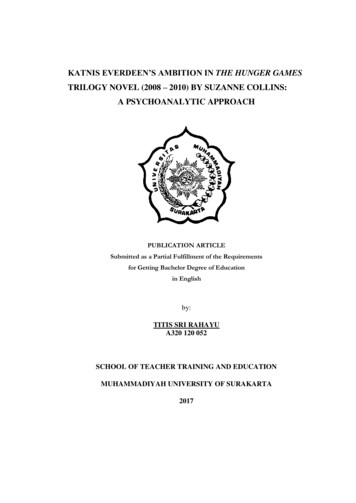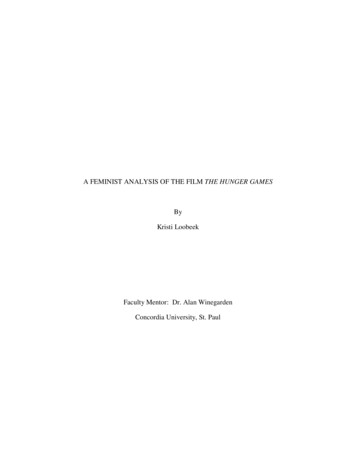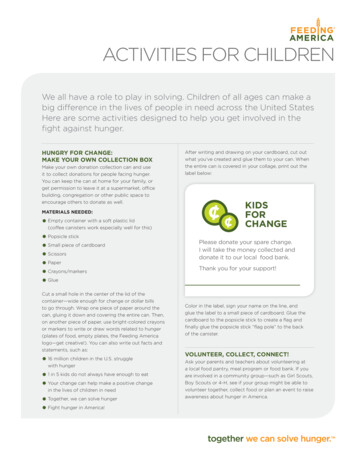
Transcription
Hunger and Its Solutions in New Jersey:A Supplemental Brief on the Landscape of the Federal Nutrition ProgramsMay 2022 www.frac.org
Table ofContentsBACKGROUND . 3FEDERAL NUTRITION PROGRAM LANDSCAPE IN NEW JERSEY. 4Supplemental Nutrition Assistance Program (SNAP) . 5Special Supplemental Nutrition Program for Women, Infants, and Children (WIC) .7Pandemic Electronic Benefit Transfer (P-EBT) .10Child Nutrition Programs .11School Breakfast Program (SBP) and National School Lunch Program (NSLP) .11Summer Nutrition Programs .12Child and Adult Care Food Program (CACFP) .12Afterschool Meal Program .14Home-delivered Meals and Congregate Senior Nutrition Programs .15Commodity Supplemental Food Program (CSFP) .16SNAP Education (SNAP-Ed) . 17CONCLUSION .18ENDNOTES .192HUNGER AND ITS SOLUTIONS IN NEW JERSEY: A Supplemental Brief on the Landscape of the Federal Nutrition Programs MAY 2022 WWW.FRAC.ORG
BackgroundFood insecurity is a significant social determinant ofhealth that affects far too many people in New Jersey.In 2020, 1 in 12 households experienced food insecurity,meaning 285,000 New Jersey households did not havereliable access to affordable, nutritious food. There are starkdisparities in food insecurity that exist within the state whichmust be addressed to create an equitable opportunityfor good health for all. Community disinvestment andsystems of oppression like systemic racism have resultedin disproportionate burdens of food insecurity alonggeographic lines and by race and ethnicity. COVID-19 hasexacerbated longstanding disparities in food insecurity andaccess to healthy food. Analysis of the Census HouseholdPulse Survey shows that in 2021, 14 percent of Blackhouseholds and 18 percent of Latino households in NewJersey indicated that they sometimes or often did not haveenough to eat, experienced “food insufficiency,” comparedto 5 percent of white households.In response to the significance of the issue of foodinsecurity and the opportunity costs of not comprehensivelyaddressing it, the Robert Wood Johnson Foundation(RWJF) and the Food Research & Action Center (FRAC)embarked on an Assessment of the Landscape of Hungerand its Solutions in New Jersey. The aim of this statewideassessment of New Jersey’s existing food access andhunger landscape is to inform stakeholders about whichpolicies, systems changes, cross-sector outreach, andprogrammatic initiatives, if implemented in the comingyears, would result in the most significant gains in foodsecurity. As part of this assessment, we actively elicitedinput from diverse stakeholders across the food systemsectors, including residents with lived expertise withhunger and poverty (hereon referred to as residents withlived expertise). We engaged more than 150 stakeholdersthrough key informant meetings, focus groups withresidents with lived expertise, and a series of advisory workgroup convenings.The results of this assessment and recommendationsgenerated from the findings can be found in the report,Hunger and Its Solutions in New Jersey: LandscapeAnalysis of Current Initiatives, Recommended Action,3and Emerging Opportunitiesfor Further Investment. Inthe report, we outlinepolicies, systems changes,cross-sector outreach, andprogrammatic initiatives tohelp reduce food insecurityand support good nutrition andhealth equity during and beyondthe public health emergency.Now is the time for stateand local policymakers,state agency leaders,community andnonprofit groups,philanthropicorganizations,leaders in the privatesector, and others tocollaborate, break out of oursilos, and collectively investin addressing food insecurity.We urge stakeholders to cometogether to advance the report recommendations.Leveraging the federal nutrition programs is a key strategyto help reduce and prevent food insecurity effectivelyand equitably. Therefore, as a supplement to the report,this brief provides further information on the landscape offederal nutrition programs in New Jersey, including programbasics, who administers the program, program participation,and COVID-19 related changes.Federal nutrition programs detailed in this brief includethe Supplemental Nutrition Assistance Program (SNAP);Special Supplemental Nutrition Program for Women,Infants, and Children (WIC); School Breakfast Program(SBP); National School Lunch Program (NSLP); SummerNutrition Programs; Child and Adult Care Food Program(CACFP), Afterschool Meal Program, Pandemic ElectronicBenefit Transfer (P-EBT), Commodity Supplemental FoodProgram, Home-delivered Meals, SNAP Education, andCongregate Senior Nutrition Programs.HUNGER AND ITS SOLUTIONS IN NEW JERSEY: A Supplemental Brief on the Landscape of the Federal Nutrition Programs MAY 2022 WWW.FRAC.ORG
FederalNutritionProgramLandscape inNew JerseySupplemental NutritionAssistance Program (SNAP)Special Supplemental Nutrition Programfor Women, Infants, and Children (WIC)Pandemic Electronic BenefitTransfer (P-EBT)Child Nutrition ProgramsHome-delivered Meals and CongregateSenior Nutrition ProgramsCommodity SupplementalFood Program (CSFP)SNAP Education (SNAP-Ed)4The federal nutrition programs—upstream approachesto help reduce and prevent food insecurity—are linkedto a wide range of positive outcomes. Federal nutritionprograms improve dietary intake and nutrition quality;support healthy growth of children; boost learning andacademic achievement; reduce poverty and increasefamily economic security; lower health care spending; andenhance food retail environments.1,2,3,4,5In New Jersey, reasonable enhancements to the federalnutrition programs have the potential to significantly reducefood insecurity and infuse millions of dollars into New Jerseylocal economies each year. The positive impacts of federalnutrition program benefits spread quickly. As families withlow incomes pay for food locally at grocery stores, farmersmarkets, and Community Supported Agriculture (CSA)programs, they support actors across the food chain, fromfarmers and food producers to long haul truck drivers, foodretailers, and store employees.6 Nutrition benefits also makea difference for state and local budgets.7 When New Jerseyresidents use federal nutrition program benefits to pay forfood, they can use other resources to pay for non-foodbasics that often are subject to sales tax. Generated revenuecan in turn can be invested in the community’s health.The food environment impacts the effectiveness of thefederal nutrition programs, and likewise, the food programsimpact food systems. Therefore, shaping food systemsto maximize the value of benefits for food programclients and leveraging the power of the food programs tosupport a robust and just food system are key strategiesto continue to improve the federal nutrition programs.Similarly, the federal nutrition programs shape our foodsystem. For example, it is well documented that food retailoutlets that accept WIC have healthier food options thansimilar outlets that do not.9 Federal nutrition programsalso increase the purchasing power of communities. Thisincreased purchasing power has been shown to incentivizeconvenience stores to become SNAP-authorized andpresents an opportunity to partner with larger grocerystores to expand into these communities. Flexibilities orincentives for local food procurement in the federal nutritionprograms provide new market channels for small andmedium food producers.10HUNGER AND ITS SOLUTIONS IN NEW JERSEY: A Supplemental Brief on the Landscape of the Federal Nutrition Programs MAY 2022 WWW.FRAC.ORG
SNAPSupplemental NutritionAssistance Program (SNAP)SNAP is a federal/state partnership. Benefits are funded100 percent by the federal government. Administrativeexpenses are shared between the U.S. Department ofAgriculture and states and counties. SNAP serves people ofall ages and in all types of communities. Those who qualifyreceive Electronic Benefit Transfer (EBT) cards to use topurchase food from authorized food retailers.By building on the regular channels of commerce, thisgovernment program provides a cost-effective, efficient,and mainstream way for millions of low-income people toobtain their groceries with dignity and in ways similar toother consumers. In federal fiscal year (FFY) 2021, 5,807food retailers in New Jersey were authorized to acceptSNAP benefits; together they redeemed a total of morethan 2.6 billion in SNAP, SNAP Emergency Allotments, andP-EBT purchases.11Federal eligibility rules provide income and resource limitsfor people to qualify for SNAP but allow states to apply fora variety of options and waivers to vary those rules.12 Mostapplicants must meet both gross and net income tests. InNew Jersey, the SNAP gross income test is 185 percentof the federal poverty level (FPL).13 This allows the stateto screen more applicants and determine whether theirexpenses for other basics like shelter and child care rendertheir net incomes at or below the net income test (100percent of the FPL).New Jersey is a county-administered and state-supervisedSNAP state. The New Jersey Department of HumanServices (DHS) is the administering agency, and countyhuman services agencies operate the program for theirrespective areas.In addition to fully funding SNAP benefits, USDAprovides money to states for conducting SNAP outreachand application assistance on a 50/50 federal/statereimbursement basis, implementing SNAP Education,known as SNAP-Ed, and offering SNAP Employment andTraining (SNAP E&T) (the latter has both a 50/50 federal/5FEDERAL NUTRITION PROGRAM LANDSCAPE IN NEW JERSEYstate reimbursement funding stream as well as a limited100 percent federal allocation). USDA also offers a numberof competitive grant opportunities. For example, in FFY2020 USDA awarded the New Jersey Human ServicesDepartment a 944,810 SNAP Process and TechnologyGrant to “redesign the online application portal and create anew customer service portal and text message notificationsystem that alerts clients to key case updates.” The newfeatures aimed “to improve customer service by increasingfunctionality that allows clients to have more access toreal-time case information.”14 We understand that the newfeatures are expected to be implemented in 2022.SNAP has positive impacts on food security, health, andwell-being.15 It also has important economic impacts. Each 1in SNAP benefits during an economic downturn generatesbetween 1.50- 1.80 in economic activity.16 Moreover, SNAPbenefits liberate participants’ tight budgets to spend moneyon other necessities that generate state tax revenue.The National Grocers Association estimates that in 2020,SNAP in New Jersey: was responsible for 3,263 jobs across grocery andsupporting industries, including agriculture, manufacturing,transportation and municipal services; generated more than 128.4 million in grocery industryjobs and related wages; and was responsible for generating 18.8 million in additionalstate and local tax revenues.17Separate funding from the Robert Wood JohnsonFoundation supported work in 2020 and 2021 by FRAC,The Food Trust, and Hunger Free New Jersey (HFNJ) to tapinput from New Jersey SNAP participants and stakeholdersto inform recommendations for improving SNAP’s reach andeffectiveness in promoting health and racial equity in NewJersey. It complemented and built on the preexisting SNAPwork group that HFNJ has convened for many years.SNAP IMPROVES THE HEALTH OF ADULTS AND SENIORS BY REDUCING:Food AnxietyMetabolicsyndrome riskDepressionriskPoor fice-based& outpatientvisitsSick daysNursing homeadmissions &costsHospitaladmissions &costsHealth carespendingHUNGER AND ITS SOLUTIONS IN NEW JERSEY: A Supplemental Brief on the Landscape of the Federal Nutrition Programs MAY 2022 WWW.FRAC.ORG
SNAPSNAP ParticipationIn recent years New Jersey has made progress on servingmore eligible people, but its 81 percent participation rate in2018 ranked 28 out of all states and the District of Columbia18and left federal funds on the table in Washington, DC, whichcould have gone to more New Jersey households in need. In2020, HFNJ estimated New Jersey’s SNAP Gap left 300,000low-income people unserved.19 Some groups have beendisproportionately affected by the gap.SNAP During COVID-19For the SNAP project in 2020 and 2021, our partner Propelconducted an online survey to elicit feedback from 500New Jersey SNAP households that subscribe to its appProviders (previously called Fresh EBT). HFNJ also partneredwith community-based organizations to garner additionalinput from New Jersey residents likely eligible for but notparticipating in SNAP. HFNJ convened a broad cross sectionof stakeholders for three virtual calls to discuss survey findings,to identify barriers to program participation particularly amongvarious populations and counties, and to develop consensusrecommendations for building on the progress New Jerseyhas made to improve SNAP’s reach and customer service.FIGURE 1EXCERPT FROM HUNGER FREE NEWJERSEY REPORT, BOOSTING NJ SNAPWhen survey respondents were asked how to make SNAPmore accessible to more New Jersey residents, the numberone answer was: Make it easier to get help from the countywelfare office. Two other top responses were related tothe application process, with respondents saying that theapplication should be easier to complete and require lessdocumentation and other paperwork.SNAP-eligible respondents also said that the benefitamount, which is set at the federal level, should behigher, and that the income limits, also set by the federalgovernment, should be raised, especially in high-cost NewJersey where people earning over the current limits stillstruggle to make ends meet.6FEDERAL NUTRITION PROGRAM LANDSCAPE IN NEW JERSEYThe report Boosting NJ SNAP: Eliminating Barriers toParticipation released in May 2021 summarizes SNAPcustomers’ feedback, outlines recommendations, and liststhe 50 stakeholder groups that participated in the project.An excerpt from the report is highlighted in Figure 1.The 2021 SNAP report recommendations fell into severalbroad categories:1. Streamline the application process by reducingpaperwork required from applicants and updating theonline application system to be user-friendly.2. Expand community outreach to educate the publicabout the program and assist more potentially eligibleresidents in completing the application process, witha focus on college students, older adults, immigrantsand the newly unemployed.3. Examine the level of customer service provided atcounty Boards of Social Services to identify challengesand solutions at the county level.The 2021 SNAP recommendations were informed byfeedback about SNAP in New Jersey prior to and duringCOVID-19. Starting in spring 2020, the federal governmentbegan offering states ways to get greater SNAP benefitamounts to SNAP households and to ease some rulesregarding enrollment and recertification.During COVID-19, New Jersey aggressively pursuedand received available federal waivers, including to (1)extend certification periods and waive periodic reportingrequirements of income or other changes betweenrecertifications; (2) eliminate interviews before beingapproved for SNAP; (3) allow telephonic signatures onapplications; and (4) increase monthly benefit amounts byleveraging the COVID-19 SNAP Emergency Allotments(EAs).20 The SNAP EAs bring all households up to themaximum benefit amount for their household size, andpursuant to Biden Administration policy, give an extra 95a month to the poorest households that already qualifiedfor maximum benefit amounts. New Jersey has continuedto leverage this federal funding and most recently wasapproved to issue EAs again in March 2022.Many of the current SNAPflexibilities are at risk whenthe federal governmentPandemic Public HealthEmergency Declarationexpires. At that point, onaverage, SNAP participants in NewJersey will lose 82 a person amonth in SNAP benefits.21 Manycollege students will lose SNAPaccess that has been eased forthem since January 2021, and timelimits on SNAP benefits for certainunemployed and underemployedadults will be applicable again across the country. Moreover,with termination of the Public Health Emergency Declaration,some SNAP procedural flexibilities will end, likely increasingburdens on both clients and caseworkers.22New Jersey could mitigate some of the negative impact onbenefit reductions if it invests funds to supplement regularfederal SNAP benefits. It also could prioritize helping moreSNAP customers claim the full value of SNAP deductionsto which they are entitled, such as child care costs incurredby households with children and medical costs incurred byclients who are elderly or have a disability.There may be some opportunities ahead for New Jerseyto gain federal approval for practices that proved effectiveduring COVID-19, possibly through waivers. Administrativeadvocacy at the federal level could improve the chancesthat USDA would provide approvals and guidance. Manyof the recommendations in the 2021 SNAP report, however,could be implemented in one or more counties withoutadditional authority. For example, additional interviewsconducted in 2022 have provided information on somework New Jersey state agencies already are pursuing forcross-program coordination and data sharing to promoteenrolling onto SNAP more WIC households and morehouseholds with children who are certified for free schoolmeals. Moreover, on an administrative basis, New Jerseyhas moved from a mandatory SNAP E&T model to avoluntary one, a much more customer-centered approach.HUNGER AND ITS SOLUTIONS IN NEW JERSEY: A Supplemental Brief on the Landscape of the Federal Nutrition Programs MAY 2022 WWW.FRAC.ORG
WICFEDERAL NUTRITION PROGRAM LANDSCAPE IN NEW JERSEYSpecial Supplemental NutritionProgram for Women, Infants,and Children (WIC)WIC is a federal nutrition program, administered by theNew Jersey Department of Health, that provides lowincome, nutritionally at-risk pregnant and postpartumindividuals, infants, and children up to 5 years old withnutritious foods, nutrition education, breastfeeding support,and referrals to health care. Income eligibility for WIC isautomatic for individuals participating in Medicaid or SNAP.For those individuals who do not have automatic incomeeligibility, the income limit is 185 percent of the povertylevel with no asset tests. The New Jersey Departmentof Health administers WIC through a network of localagencies that provide services through WIC clinics.WIC is an important resource for New Jersey familieswith young children. WIC improves participants’ health,dietary intake, and birth and health outcomes.23 WICalso supports learning and development, reduces foodinsecurity, and helps to alleviate poverty. In addition, WICsupports economic stability and improves the availabilityof healthy foods in low-income communities throughparticipating stores.WIC ParticipationIn 2019, 58.1 percent of the approximately 230,000WIC-eligible persons in New Jersey participated in theprogram24; this is an increase from 57.0 percent in 2018.25The proportion of eligible persons participating, or coveragerate, varies by participant category. Almost 95 percent ofeligible infants participated in WIC, but only 47 percent ofeligible children participated in New Jersey in 2019. TheU.S. average coverage rate is 57.4 percent, and New Jerseyranks 21st in coverage rate compared to other states (bestto worst). Millions of dollars are being left on the table withjust over half of eligible participants enrolled in the program.In federal fiscal year 2021, New Jersey WIC served anaverage of 141,700 participants each month.26 Participationhas continued to grow with 142,800 participants enrolledin WIC in October 2021, the latest available month ofdata. This represents a 7.9 percent increase compared toFebruary 2020 (132,400 participants), the baseline monthbefore the COVID-19 pandemic.Improves birthoutcomes7AlleviatespovertyImproves healthoutcomesSupports economicstabilitySupports learningand developmentImproves dietaryintakeReduces health careand other costsNew Jersey has performed well on increasing WICparticipation over this period compared to the Mid-Atlanticregion and the nation. The Mid-Atlantic region had a 2.2percent decline in participation, and the nation had a 3.3percent increase from February 2020 to October 2021.Trends are detailed in this New Jersey WIC profile.If WIC participation were to increase an additional 7.9percent in New Jersey, the increase in benefits wouldconservatively bring in an additional 4.7 million per yearto local grocery stores and economies.27 This estimate islow as it does not factor in the increased value of WIC’sfruit and vegetable benefit, which increased the value ofmonthly fruit and vegetable vouchers from 9 for childrenand 11 for pregnant and postpartum participants to 24for children and 43– 47 for pregnant and postpartumparticipants. This increase is authorized throughSeptember 2022 and may be extended. New Jersey isone of the states that allows regular monthly fruit andvegetable benefits to be redeemed at approved farmersmarkets and roadside stands, furthering the potential forWIC to directly benefit local agriculture and communities.WIC participation did not change at the same rate in all NewJersey counties, with some counties increasing participationand some decreasing. A variety of potential factors impactthese WIC participation rates including the rate of increasedneed, local WIC agency staff and outreach capacities, and avariety of local circumstances.THE WIC PROGRAM:Reduces foodinsecurityWIC During COVID-19Protects againstobesityImproves retail foodenvironmentsWIC Outreach: Counties have varying levels of WICoutreach, promotion, and coordination with WICparticipants and other sectors. Effective WIC outreachand referral partnerships and coordination with thehealth care sector, social service providers, advocates,emergency food providers, and community partnersfacilitate WIC access and help address health inequities.Staff Capacity: Entering COVID-19, counties hadvarying levels of capacity to manage the increasednumber of families eligible for services. Some localagencies could not pivot to remote services aseasily, some were understaffed and overburdenedHUNGER AND ITS SOLUTIONS IN NEW JERSEY: A Supplemental Brief on the Landscape of the Federal Nutrition Programs MAY 2022 WWW.FRAC.ORG
WICFEDERAL NUTRITION PROGRAM LANDSCAPE IN NEW JERSEYby increased caseloads, unable to meet demand.It is possible that some public health departmentsredirected some WIC staff time to COVID-19 contacttracing and other tasks.When comparing the change in WIC participation tomeasures of health outcomes via our GIS map, Mercer andCumberland counties have relatively high infant mortalityand low birthweight rates, and both had large declines inWIC participation during COVID-19. Since WIC has beenshown to improve birth outcomes,28 specialized efforts toenroll pregnant individuals would be especially beneficialin these counties.SPOTLIGHTUpcoming Opportunity—WIC and WICFarmers’ Market Nutrition ProgramOutreach, Innovation, and ProgramModernization StrategyThe American Rescue Plan Act provided the U.S.Department of Agriculture (USDA) with 390 million foroutreach, modernization, and innovation efforts for WICand the WIC Farmers’ Market Nutrition Program. USDAhas developed a framework for investment of the fundsincluding the following efforts to: raise awareness of WIC’s benefits and services; certify people for program benefits in a way that isparticipant centered; improve the shopping experience; and ensure equitable access to program benefits via buildingnew local partnerships to ensure WIC clinics are meeting theneeds of their service community and providing culturallyappropriate and competent care.New Jersey WIC can leverage this strategy to increase WICenrollment and retention and reduce disparities in programdelivery as funding is made available.8HUNGER AND ITS SOLUTIONS IN NEW JERSEY: A Supplemental Brief on the Landscape of the Federal Nutrition Programs MAY 2022 WWW.FRAC.ORG
WICThe New Jersey Department of Health acted quicklyduring COVID-19 to implement federal waivers that haveallowed WIC to offer appointments over the phone, issuebenefits remotely, and offer flexibilities in the WIC shoppingexperience like substitutions for unavailable food products.Together, these temporary changes have streamlinedaccess to the program for families and enabled participantsto use their WIC benefits more fully amidst food supplychain issues and social distancing requirements.Participants in our focus groups ubiquitously expressedappreciation for remote access to WIC during COVID-19and that they would like to see remote servicescontinued in addition to in-person options. Participantsliked remote benefit access because it saved them time,was safer for them and their families, and produced highquality service.“With having to work full time eventhrough COVID and with the kids,getting the phone calls was so mucheasier and I was thankful for thatbecause the services didn’t stop, andwe were able to get the informationover the phone.” — Focus group participantFEDERAL NUTRITION PROGRAM LANDSCAPE IN NEW JERSEY“At the register it gets veryembarrassing—you hold the lineup; most cashiers do not know howto do it. If you picked the wrongitem, I usually just pass on it becauseeverybody’s looking at me and it’s anuncomfortable experience.”— Focus group participantFocus group participants who are enrolled in WICexpressed they sometimes felt frustration andembarrassment when using WIC benefits at the grocerystore. Inadequate labeling of WIC-approved foods, cashiers’low perceptions and knowledge of WIC, too few WICvendors, and discrepancies between foods advertised inthe Food Guide as WIC approved versus which foods thestores would accept as WIC approved were frequentlycited as needs to address in the WIC shopping experienceby focus group participants. Some participants have eventried changing stores or forgo certain foods on their benefitvoucher because of this issue. Participants recommendedbetter labeling of WIC foods, more WIC training for storeemployees, a dedicated clerk for WIC purchases, and anon-demand WIC advocate to help with discrepancies atthe store. WIC-Only Stores were discussed as a potentialsolution to challenges with the WIC shopping experience.SPOTLIGHTStatewide eWIC RolloutAll New Jersey WIC participants will soon receive andredeem their nutrition benefits using an eWIC card (a cardsimilar to a debit card) in place of benefit check vouchers.New Jersey WIC has successfully piloted eWIC in threecounties, and statewide rollout began in January 2022.Accompanying the new eWIC technology is a WIC ShopperApp that will allow participants to view their benefits, findtheir nearest grocer or WIC office, and scan food items atthe store to check for eligibility.In addition to navigating COVID-19 related changes,including an increase in fruit and vegetable benefits,New Jersey WIC is in the process of transitioning frompaper voucher benefits to electronic benefits on aneWIC card. Participants are eager for the transition toeWIC in the hopes of alleviating some of the stress andembarrassment that can accompany using WIC checkvouchers at the store. As vendors work to changeover their point-of-sale technologies to accommodatethe new eWIC system, ensuring equitable access forfarmers markets, other small vendors, and vendors whoprimarily serve immigrant families remained a priority forstakeholders that we engaged.9HUNGER AND ITS SOLUTIONS IN NEW JERSEY: A Supplemental Brief on the Landscape of the Federal Nutrition Programs MAY 2022 WWW.FRAC.ORG
P-EBTFEDERAL NUTRITION PROGRAM LANDSCAPE IN NEW JERSEYPandemic Electronic BenefitTransfer (P-EBT)Pandemic Electronic Benefit Transfer(P-EBT), created in March 2020,provides nutritional resources tofamilies who have lost access tofree or reduced-price school mealsdue to school or child care closures.Families receive money on a newor exis
reliable access to affordable, nutritious food. There are stark disparities in food insecurity that exist within the state which must be addressed to create an equitable opportunity for good health for all. Community disinvestment and systems of oppression like systemic racism have resulted in disproportionate burdens of food insecurity along











